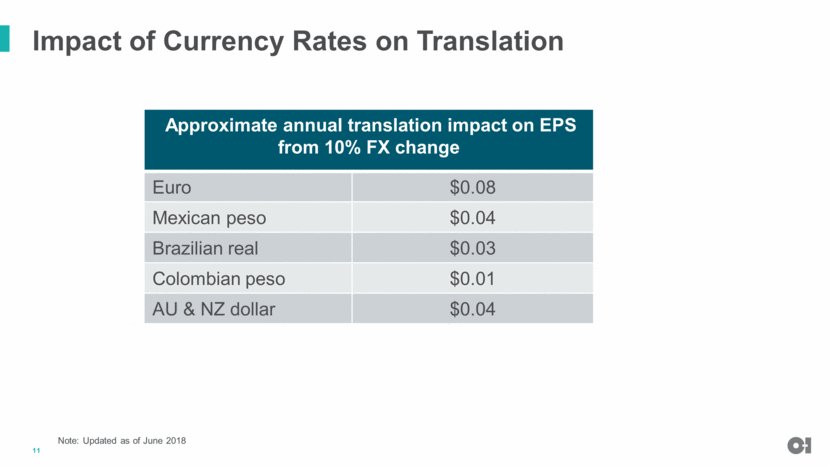Attached files
| file | filename |
|---|---|
| 8-K - 8-K - O-I Glass, Inc. /DE/ | a18-14963_18k.htm |
Deutsche bank 2018 global industrials & materials summit Andres Lopez, CeO Jan Bertsch, cfo June 7, 2018 Owens-Illinois

Forward-Looking Statements This document contains "forward-looking" statements within the meaning of Section 21E of the Securities Exchange Act of 1934, as amended (the “Exchange Act”) and Section 27A of the Securities Act of 1933. Forward-looking statements reflect the Company's current expectations and projections about future events at the time, and thus involve uncertainty and risk. The words “believe,” “expect,” “anticipate,” “will,” “could,” “would,” “should,” “may,” “plan,” “estimate,” “intend,” “predict,” “potential,” “continue,” and the negatives of these words and other similar expressions generally identify forward-looking statements. It is possible the Company's future financial performance may differ from expectations due to a variety of factors including, but not limited to the following: (1) foreign currency fluctuations relative to the U.S. dollar, (2) changes in capital availability or cost, including interest rate fluctuations and the ability of the Company to refinance debt at favorable terms, (3) the general political, economic and competitive conditions in markets and countries where the Company has operations, including uncertainties related to economic and social conditions, disruptions in the supply chain, competitive pricing pressures, inflation or deflation, and changes in tax rates and laws, (4) the Company’s ability to generate sufficient future cash flows to ensure the Company’s goodwill is not impaired, (5) consumer preferences for alternative forms of packaging, (6) cost and availability of raw materials, labor, energy and transportation, (7) the Company’s ability to manage its cost structure, including its success in implementing restructuring plans and achieving cost savings, (8) consolidation among competitors and customers, (9) the Company’s ability to acquire businesses and expand plants, integrate operations of acquired businesses and achieve expected synergies, (10) unanticipated expenditures with respect to environmental, safety and health laws, (11) unanticipated operational disruptions, including higher capital spending, (12) the Company’s ability to further develop its sales, marketing and product development capabilities, (13) the failure of the Company’s joint venture partners to meet their obligations or commit additional capital to the joint venture, (14) the Company’s ability to prevent and detect cybersecurity threats against its information technology systems, (15) the Company’s ability to accurately estimate its total asbestos-related liability or to control the timing and occurrence of events related to asbestos-related claims, (16) changes in U.S. trade policies, (17) the Company’s ability to achieve its strategic plan, and the other risk factors discussed in the Annual Report on Form 10-K for the year ended December 31, 2017 and any subsequently filed Annual Report on Form 10-K, Quarterly Report on Form 10-Q or the Company’s other filings with the Securities and Exchange Commission. It is not possible to foresee or identify all such factors. Any forward-looking statements in this document are based on certain assumptions and analyses made by the Company in light of its experience and perception of historical trends, current conditions, expected future developments, and other factors it believes are appropriate in the circumstances. Forward-looking statements are not a guarantee of future performance and actual results or developments may differ materially from expectations. While the Company continually reviews trends and uncertainties affecting the Company's results of operations and financial condition, the Company does not assume any obligation to update or supplement any particular forward-looking statements contained in this document. The Company routinely posts important information on its website – www.o-i.com/investors. Safe Harbor Comments 2
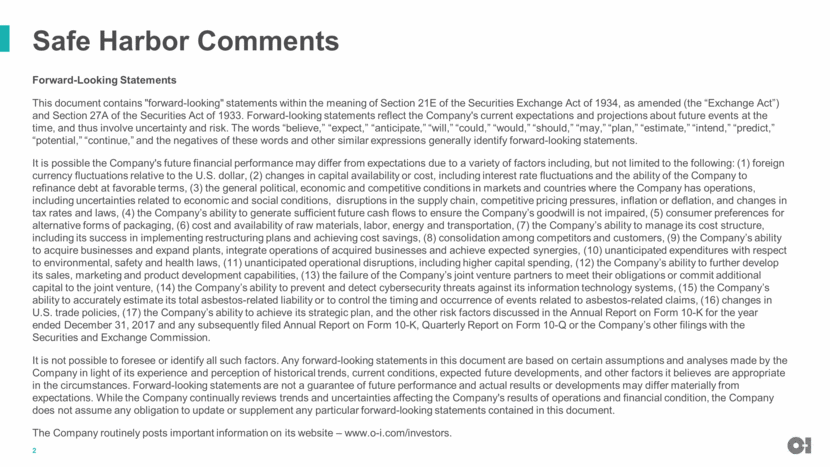
Sustainable value creation MARKET TRENDS & REGIONAL DYNAMICS CAPABILITY BUILDING STRATEGIC INVESTMENTS PEOPLE & CULTURE MULTIPLIER x + + = HIGHER EARNINGS & CASH FLOW 3

O-I Americas Spotlight: Outperforming in U.S. Market U.S. Beer Shipments in Glass (Index 2010=100) Source: Beer Institute and O-I data Note: For clarity, the JV with CBI is a non-consolidated joint venture which impacts O-I financial statements through equity earnings; partial year shipments from the JV with CBI in 2014 are not included. O-I U.S Volumes by Key Categories (Index 2012 = 100) O-I Beer containers in the U.S. is increasing Since 2014, the strong performance of the JV with CBI outweighs U.S. megabeer trends U.S. industry beer shipments in glass have declined ~12% since 2010 O-I’s product mix favors growing categories Commercial efforts to diversify are paying off Consumer preferences for premium products in glass drive growth in Food and Non-Alcoholic Beverages Spirits, wine continue to take share of alcoholic beverages Exposure to beer imports via JV with CBI 4 JV with CBI Non-Alcoholic Food Other Alcohol Mega Beer Other Beer 85 90 95 100 105 110 2010 2011 2012 2013 2014 2015 2016 2017 Total Industry O-I (incl JV with CBI) 2012 2017 - 20 40 60 80 100 120 2012 2017
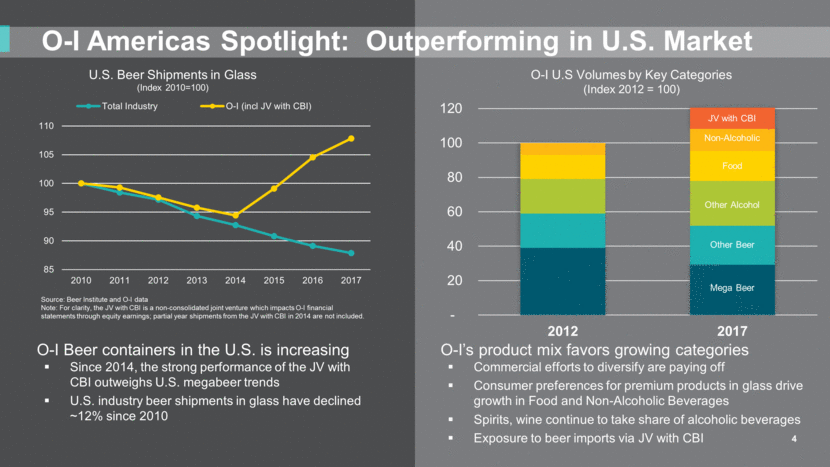
Asset Optimization on Track Network Optimization Complete Shutdown Schiedam, NL facility Balanced supply-demand for O-I in Europe On track Colombia realignment Improved cost position and flexibility, after consolidating two plants into one Announced Shutdown Atlanta, GA facility Roughly balanced supply-demand for O-I in the U.S. Focused Investment to Increase Flexibility and Fit-to-market On track Americas Several years into program to increase flexibility in non beer categories On track Europe Several years into program to improve structural costs and flexibility On track Asia Pacific Heavy investment through mid-year 2018 to improve fit to market and unwind higher-than-normal transportation costs 5
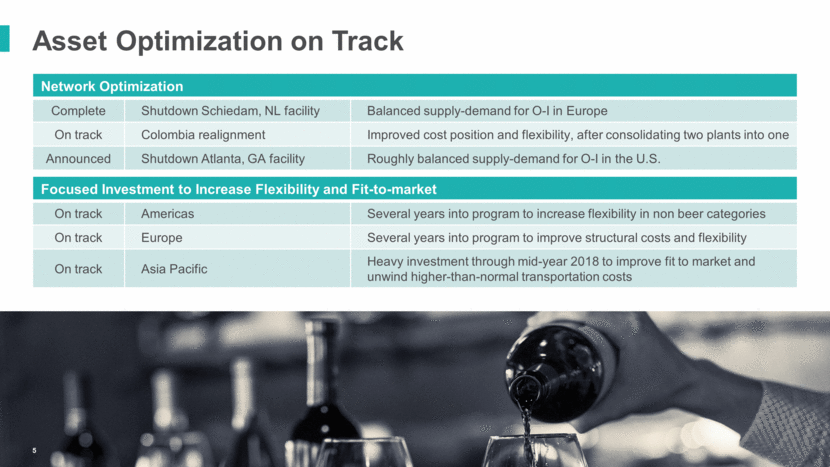
6 Working to offset sizeable external factors, such as FX, interest rates, Brazil transportation strikes Line of sight to full year guidance FY2018 Adjusted EPS1 $2.75 – $2.85 FY2018 Adjusted free cash flow2 ~$400M 2Q18 Adj. EPS ~$0.75, impacted by many moving pieces: Solid overall business performance Asset improvements on track Energy credit in Europe Accretive share buybacks Lower effective tax rate in quarter Strong US Dollar impacts translation and cost inflation External and internal factors in Brazil and Mexico 2Q and FY 2018 Guidance 1 Adjusted EPS excludes items management does not consider representative of ongoing operations. 2 Adjusted free cash flow is defined as cash provided by continuing operating activities less additions to property, plant and equipment plus asbestos-related payments. + + + + + - -

Appendix 7

8 The Company uses certain non-GAAP financial measures, which are measures of its historical or future financial performance that are not calculated and presented in accordance with GAAP, within the meaning of applicable SEC rules. Management believes that its presentation and use of certain non-GAAP financial measures, including adjusted earnings, adjusted earnings per share, segment operating profit, segment operating profit margin and adjusted free cash flow, provide relevant and useful supplemental financial information, which is widely used by analysts and investors, as well as by management in assessing both consolidated and business unit performance. These non-GAAP measures are reconciled to the most directly comparable GAAP measures and should be considered supplemental in nature and should not be considered in isolation or be construed as being more important than comparable GAAP measures. Adjusted earnings relates to net earnings from continuing operations attributable to the Company, exclusive of items management considers not representative of ongoing operations because such items are not reflective of the Company’s principal business activity, which is glass container production. Adjusted earnings are divided by weighted average shares outstanding (diluted) to derive adjusted earnings per share. Segment operating profit relates to earnings from continuing operations before interest expense (net), provision for income taxes and is also exclusive of items management considers not representative of ongoing operations. Segment operating profit margin is segment operating profit divided by segment net sales. Management uses adjusted earnings, adjusted earnings per share, segment operating profit and segment operating profit margin to evaluate its period-over-period operating performance because it believes this provides a useful supplemental measure of the results of operations of its principal business activity by excluding items that are not reflective of such operations. Adjusted earnings, adjusted earnings per share, segment operating profit and segment operating profit margin may be useful to investors in evaluating the underlying operating performance of the Company’s business as these measures eliminate items that are not reflective of its principal business activity. Further, adjusted free cash flow relates to cash provided by continuing operating activities less additions to property, plant and equipment plus asbestos-related payments. Management uses adjusted free cash flow to evaluate its period-over-period cash generation performance because it believes this provides a useful supplemental measure related to its principal business activity. Adjusted free cash flow may be useful to investors to assist in understanding the comparability of cash flows generated by the Company’s principle business activity. Since a significant majority of the Company’s asbestos-related claims are expected to be received in the next ten years, adjusted free cash flow may help investors to evaluate the long-term cash generation ability of the Company’s principal business activity as these asbestos-related payments decline. It should not be inferred that the entire adjusted free cash flow amount is available for discretionary expenditures, since the Company has mandatory debt service requirements and other non-discretionary expenditures that are not deducted from the measure. Management uses non-GAAP information principally for internal reporting, forecasting, budgeting and calculating compensation payments. Non-GAAP Financial Measures

9 Reconciliation to Adjusted Earnings

10 Reconciliation to Adjusted Free Cash Flow Note: Management defines adjusted free cash flow as cash provided by continuing operating activities less additions to property, plant and equipment plus asbestos-related payments (all components as determined in accordance with GAAP).
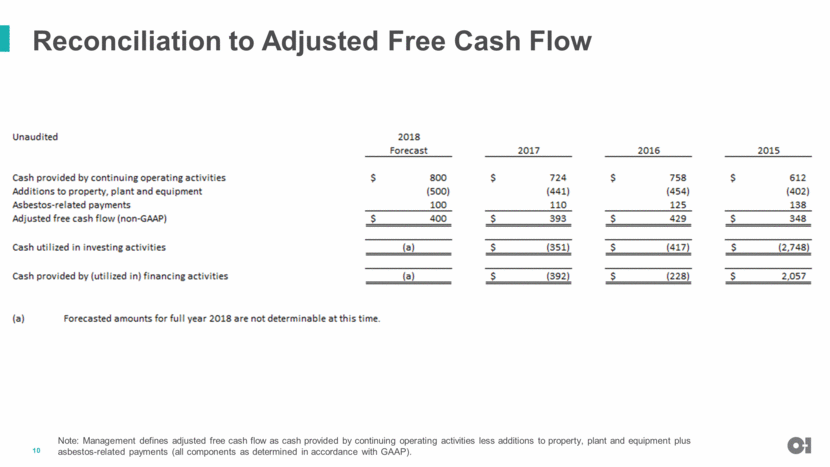
11 Impact of Currency Rates on Translation Note: Updated as of June 2018 Approximate annual translation impact on EPS from 10% FX change Euro $0.08 Mexican peso $0.04 Brazilian real $0.03 Colombian peso $0.01 AU & NZ dollar $0.04
